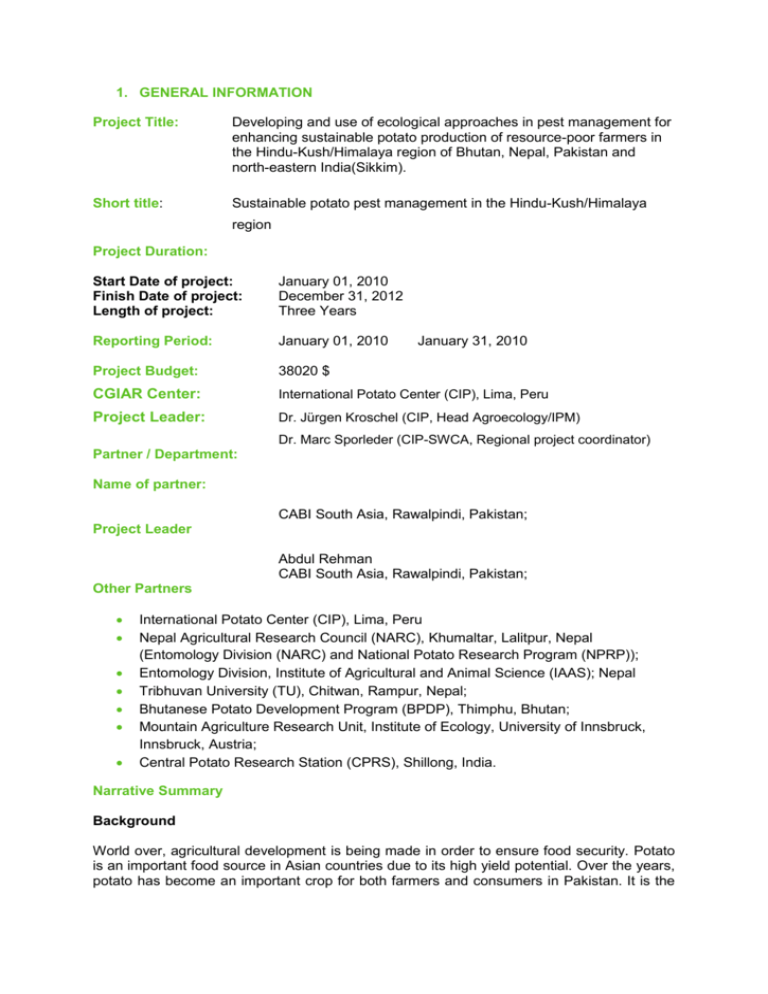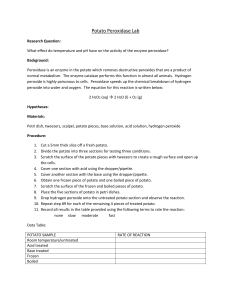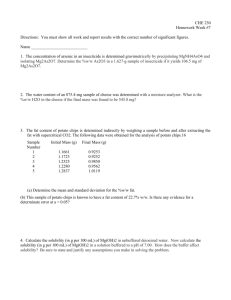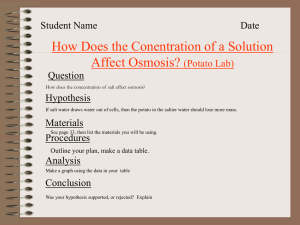Project Leader
advertisement

1. GENERAL INFORMATION Project Title: Developing and use of ecological approaches in pest management for enhancing sustainable potato production of resource-poor farmers in the Hindu-Kush/Himalaya region of Bhutan, Nepal, Pakistan and north-eastern India(Sikkim). Short title: Sustainable potato pest management in the Hindu-Kush/Himalaya region Project Duration: Start Date of project: Finish Date of project: Length of project: January 01, 2010 December 31, 2012 Three Years Reporting Period: January 01, 2010 Project Budget: 38020 $ CGIAR Center: International Potato Center (CIP), Lima, Peru Project Leader: Dr. Jürgen Kroschel (CIP, Head Agroecology/IPM) January 31, 2010 Dr. Marc Sporleder (CIP-SWCA, Regional project coordinator) Partner / Department: Name of partner: CABI South Asia, Rawalpindi, Pakistan; Project Leader Abdul Rehman CABI South Asia, Rawalpindi, Pakistan; Other Partners International Potato Center (CIP), Lima, Peru Nepal Agricultural Research Council (NARC), Khumaltar, Lalitpur, Nepal (Entomology Division (NARC) and National Potato Research Program (NPRP)); Entomology Division, Institute of Agricultural and Animal Science (IAAS); Nepal Tribhuvan University (TU), Chitwan, Rampur, Nepal; Bhutanese Potato Development Program (BPDP), Thimphu, Bhutan; Mountain Agriculture Research Unit, Institute of Ecology, University of Innsbruck, Innsbruck, Austria; Central Potato Research Station (CPRS), Shillong, India. Narrative Summary Background World over, agricultural development is being made in order to ensure food security. Potato is an important food source in Asian countries due to its high yield potential. Over the years, potato has become an important crop for both farmers and consumers in Pakistan. It is the fourth most important crop by volume of production; it is high yielding, having a high nutritive value and gives high returns to farmers. Potatoes are one of the most important vegetable crops of Northern Areas of Pakistan. It is a major cash crop for many small-scale farmers in the Northern areas of Pakistan. Agriculture in Northern areas of Pakistan is mainly at subsistence level, gradually transforming into commercial enterprise. Vegetable production especially seed potato is one of the major agricultural activities of this area. The project addresses pest management issues, including agricultural production losses caused by pests, and the impacts on the environment and human health of increasing pesticide use in the Hindu Kush-Himalaya (HKH) of Pakistan. The project builds on CIP’s experience in agroecology and integrated pest management (IPM) research in potato production systems. It seeks to achieve sustainable impact in pest management in the HKH through a better understanding of potato agroecosystems and the development and application of biological control, in collaboration with its national partners in CIP priority countries in Southwest-Central Asia (SWCA) (CIP, 2003). Increasing but unsustainable potato production Although potato production in Pakistan has been increased many folds but its per acre yield is far less than other parts of the world. (Malik, 1995). In the last decade, potato production has increased by an average of about 3% in Pakistan. Reliance on pesticides But evidence shows that potato production in many Asian countries is not sustainable because of intensive use of pesticides to control pests and diseases. These result in hazards to human health and the environment. Adherence to FAO’s (1990) “Code of Conduct on the Distribution and Use of Pesticides” is rarely observed, highly hazardous 1a and 1b class pesticides (according to the World Health Organization’s (WHO) 2002 classification) are still widely available, the quality of protection equipment, if worn, is poor, and collection services for used pesticide containers are absent. The lack of market access, cold storage facilities and the non – familiarity of the growers with modern farming methods are some of the factors discouraging the cultivation of this valuable and nutritious vegetable on a large scale. The other major factor is that the growers are not satisfied with the return they get from this crop. Although potato is major cash crop, the only source of living for most of the households living in the region. But unfortunately even government is not taking serious measures to discourage the groups/ agents who unite themselves as a cartel to influence the price. So the product is sold at lower prices which in turn reduce the income of the growers. Goal: Contribute to achieve the MDGs in the HKH region by improving food security and lively hoods of farmers through sustainable pest management in potato. Purpose: Farm income of resource-poor farmers of the HKH region is enhanced by the implementation and use of ecologically based IPM approaches in target regions of Bhutan, Nepal, Pakistan and India (Sikkim). Outputs: 1. Understanding of insect communities and pest-natural enemies’ relationships in potato-based cropping systems in different agroecological zones. 2. The potential for classical biological control for key invasive potato insect pests (PTM, all countries; LMF, Nepal) evaluated and host specific parasitoids introduced, mass reared and naturalized in selected target areas. 3. Biopesticides for key potato pests developed and tested. 4. Integration of biorationals, local botanicals and low-toxic and systemic insecticides tested in action research with farmers. 5. Integrated disease management technologies for late blight and wart developed for major agro climatic conditions of Nepal. 6. Research capacities of implementing partner institutions strengthened and scientists in EPM trained. 7. Farmers in EPM trained and developed technologies introduced and scaled-out. Previous achievements First reporting Achievements in current Year Participated in A 3-day project “start-up” meeting was held in Kathmandu from 24th - 26th November, 2009,in which an operational plan has been finalized. Output 1: Act 1: Research protocols for insect collections from major potato-based cropping systems in different agro ecological zones of Pakistan (activity 1.1) were finalized; study sites for the 2010 cropping season in low, mid and high hills were selected in Pakistan. The selected sites were given in the following table. Table 1: Sites selected for activity 1.1. Replication 1 Country Altitude level per area (village) Pakistan High 1) Khaplu ( 2000 masl) 2) Hashupi, Shigar valley, Skardu GPS data Landscape Longitude Latitude Altitude (masl) (rich/poor) E 076o 23.219 E 075o 40.573 E 075o 29.459 E 074o 31.058 E 074o 18.346 N 35o 08.812 N 35o 30.484 N 35o 20.514 N 35o 57.564 N 36o 14.342 2998 Moderate 2361 Moderate 2919 Moderate 2067 Moderate 1755 Moderate E 073o Chatorkhand, 50.525 Ishkoman Valley, Ghizer N 36o 21.072 2058 Moderate E 073o 12.426 E 073o 13.248 N 34 o 14 297 N 34 o 26.082 1117 Rich 905 Rich E 073o 14.072 N 34 o 26.440 938 Rich 3)Chunda, Skardu Middle 1) Sinaker, Bagrote ( 1500 masl) valley, Gilgit 2) Chalt, Nagar valley, Hunza Nagar 3) Lower mid hills 1) More Kalan, Abbottabad ( 1000 masl) 2) Baffa, Mansehra 3) Bajna, Mansehra Following traps were installed on the selected sites and insects tapped were collected at given intervals according to agreed protocol and taken back to lab for further identification. a) Malaise Trap b) Yellow Sticky Traps c) d) e) f) g) Window Pan Traps Pitfall traps Light Trap Pheromone Traps for Potato tuber moth, Agrotis sp. Hobo Pendants for temperature and Light Intensity Agroecological studies (insect collections) were conducted in high, mid, and low hills (from 3 plots in each zone) in Pakistan from January to July. Fortnightly basis collection of insects were made and processed. Last collection from high and mid hills could not be obtained due to flood and blocking of roads. Collections from low hills compiled. Act. 2: The questionnaire for the diagnostic survey on farmer’s constraints in potato production, pest management strategies and yield losses due to key pests was received and modified according to the local requirements. Act. 3: Collection of insects from high and mid hills have been started (2nd year replication of plots used in act. 1) and further 3 plots in these zone have been included which are pesticide free for evaluating pesticide effects. Act. 4: Pests and antagonist were monitored in plots selected for act. 1. Population dynamics of PTM and Agrotis ipsilon were monitored year-round in Pakistan using pheromone traps. There was not a single potato tuber moth captured in those traps installed at nine locations of high, mid and low altitudes of Himalaya region of Pakistan. Act. 5: White grubs (WG) have been collected from six different sites of low and high hills. Adult scab beetles and larval samples were collected. All the collection have been preserved according to the standard procedures in alcohol at Rawalpindi laboratory. Output 2: Act. 1-5: No work has been done on preparation of dossiers for the importation of parasitoids as it was decided in the planning meeting that there is no authentic report for the presence of potato tube moth from the Pakistan and for this purpose population dynamic survey will be conducted using pheromone traps throughout the project area. Up till now not a single specimen of potato tuber moth has been collected from the pheromone traps obtained from CIP installed at in project area. In my opinion we have conduct survey again to confirm the presence/absence of the potato tuber moth and as well as expand the survey for the potato tuber moth in potato growing regions of other parts of the country. Output 6: Act.1: Scientists and field assistant from local government institutions were trained on different EPM research methodologies on the job. Act. 2: Still no specific training courses and intra-country visits for project stakeholders were performed. Output 7: Act.1: Farmers were involved in participatory research activities (action research) as described above. Act. 2: No specific farmers’ field days has been performed at this stage (except that farmers in selected sites were briefed about the project activities and data collection procedures, all farmers agreed to participate in this experiment). Act. 3-5: Still no field guides on pests and natural enemies and EPM in local languages have been published, extension officers trained, and country specific guidelines for EPM in potato production develop at this stage. Planned activities for the next year Output 1: Act. 1: Samples collections will be made after the new selection of sites (2nd year replication) as some of previous sites are now difficult to access due to bad road conditions and weather after the disastrous flood in Pakistan. Survey for the potato tuber moth will conducted again and expanded to other potato growing areas of Pakistan. Act. 2: Six major districts (Major districts involved are: Abbottabad, Mansehra, Gilgit, Skardu, Ghanche and Hunza Nagar) will be surveyed in 2011 to finalize the diagnostic survey with baseline components. Data will be organized in an Access database and analyzed. Act. 5: The random selection of WGs from 6 districts resulted unexpectedly in low numbers of species collected. The collection of WG will be continued focusing more on areas/zones from where farmers reported increasing WG incidence. Sequencing and barcoding will be start. Output 2: Act. 1: Diagnostic survey area for the PTM will be conducted again in the project area and expanded to other potato growing locations in Pakistan. Output 7: Act.1: Action research will be extended during the 2011/2012 project phase. Act. 2: Organize field days and farmer-to-farmer visits. Act. 3: Publish field guides on pests and natural enemies and EPM in local languages. Act. 4: Train extension staff on EPM in potato Act. 5: Develop country specific guidelines for EPM in potato production. 2. Management Issues Update on Personnel Changes No change Financial Resources Funds available Research sites All activities have conducted according to the planed schedule. During the July 2010 a devastating flood hit the mountainous and plain areas of Pakistan resulting damage of field crops, houses and infrastructure. After flood in August 2010 practically it would not be possible to move in the field area for the project activities. Accessibility to the project selected sites was not possible. Many relief and rehabilitation activities are started by many organizations in flood affected areas of Pakistan. Now it is hoped that we can revive our activities as many of the bridges and alternative ways has been made. 3. Passed research process Potato tuber moth was not captured in pheromone traps form the selected sites. It has been decided to increase the PTM pheromone sites during the next year survey plan. 4. Dissemination of Out puts All project activities were shared with government agricultural extension staff and farmers. They were also involved in insect collection process. 5. Project implementation No changes have been made to the work plan presented in the project proposal. The operational plan as presented last year (Excel file: “Operational Plan-Start-up planning workshop 11-09”) will be followed-up as described above in section 1. 6. Financial Statement Received: 38,020.00 US$ Total expenditure: 34,710.00 US$ (Dec. 2010) Balance: 3,310.00 US$ (for details see attaché Excel file: “Financial Report Jan 2010_CABI Asia.xls”) 7. Other comments None Annex A Site 1. Low Hills. More Kalan (Abbottabad) Pheromone trap for Agrotis ipsilon Selected Potato Field Temperature / Light Pendant Agrotis ipsilon captured in pheromone traps Yellow Sticky Trap Agrotis ipsilon moth at pheromone capsule in Trap Unidentified Moth Helicoverpa armigera larvae on Potato leaves Potato Tuber Moth pheromone traps Pitfall trap Window Pan trap Site 2. Low Hills. Inayatabad Baffa Mansehra Spodoptera litura in Pheromone trap Temperature / Light Pendant Collection of insects from Pitfall Trap Malaise Trap Spodoptera litura in Pheromone trap Pitfall Trap Site 1. Low Hills. Bajna, Mansehra Lady Bird Beetles on Potato leaves Temperature / Light Pendant Potato exposed to light and regenerated Malaise Trap Malaise Trap






